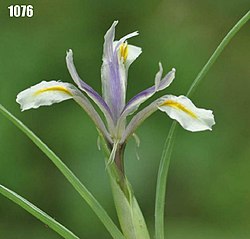Biology:Iris narbutii
| Iris narbutii | |
|---|---|

| |
| Scientific classification | |
| Kingdom: | Plantae |
| Clade: | Tracheophytes |
| Clade: | Angiosperms |
| Clade: | Monocots |
| Order: | Asparagales |
| Family: | Iridaceae |
| Genus: | Iris |
| Subgenus: | Iris subg. Scorpiris |
| Section: | Iris sect. Scorpiris |
| Species: | I. narbutii
|
| Binomial name | |
| Iris narbutii O.Fedtsch
| |
| Synonyms[1] | |
| |
Iris narbutii is a species of flowering plant in the genus Iris, subgenus Scorpiris. It is a bulbous perennial from Central Asia. It has dark green leaves, short stems, spring flowers in shades of greenish-yellow to pale violet.
Description
Iris narbutii has a brown bulb with papery tunic,[2] the bulb is approx. 2 centimetres (0.79 in) in diameter.[3] It has thickened roots,[4] which look similar to fat short pointed tubers.[5] The thin, channelled dark green leaves emerge before the flowers, they are 5–25 mm wide (close to the base of the plant).[4][6][3] They gradually narrow to an apex (falcate-like or lanceolate),[2] and have a very visible white edging/margin.[4]
One of the shorter Juno irises, similar to Iris leptorrhiza,[2] only growing to a height of 5–10 cm (2.0–3.9 in).[4][6][7]
It blooms in early-mid spring,[3] flowering between January and April depending on the weather conditions.[4][2][6] It has 1 or 2 scentless flowers per bulb stem.[4][3][7]
The flowers come in a range of shades from greenish-yellow to pale violet.[2][6][7] The green-purple perianth tube is about 4–5 cm (1.6–2.0 in) long.[4][3] It has standards (3.5–5 cm or 1.4–2.0 in) that hang downwards.[6][8][9] It has falls that start upright, but then the blade bends downwards, with a dark violet blotch at the tip. They have a raised white crest surrounded by a yellow zone/area.[2][7][9] The yellow zone can sometimes have a dark purple ring around it.[3]
It has whitish pollen.[4]
Taxonomy
It is sometimes misspelt as 'Iris narbuti'.[10][11]
It was first published as Juno narbutii by Olga Fedtschenko in 'Izvestiya Imperatorskago Obscestva Ljubitelej Estestvoznanija, Antropologii i Etnografii, Sostojascago pri (Imperatorskom) Moskovskom Universitete' in 1902.[12] It was later published as Iris narbutii by Boris Fedtschenko in Bull. Jard. Bot. St. Petersb. Vol.V on page 157 in 1905.[4]
Iris narbutii is now an accepted name by the RHS.[13]
It is listed in 1995 in 'Vascular plants of Russia and adjacent states (the former USSR)' by Czerepanov, S. K.[14]
It may have been named after 'Narbuta Beg'(1774-1798), a grandson of 'Abd al-Karim' (Khanate of Kokand) of the Fergana Valley, Central Asia, where the iris was found.[15]
Native
Iris narbutii is from Central Asia.[7][9] Originally found on the slopes of Syr-Darya river valley.[4][8]
It is found on the rocky, gravelly slopes of the mountains of western Tien Shan and southern Pamir Mountains.[3] Also seen near to Samarkand and Tashkent.[4]
Olga Fedtschenko had speculated that the plants from west Tien Shan, could be a separate species, due to their paler colour.[4]
In Chulbair Mountains, Uzbekistan, it is a threatened species and close to extinction.[2]
Cultivation
It can be seen growing in the 'Le Grand Clos Botanique Garden' in Bourgueil, France.[16]
It can be cultivated in pots,[2] or in well-drained soils in sunshine (like other Juno irises).[6]
Known hybrids
- Iris narbutii 'Kara Kaga'[9]
In Russia, Vvedenskii had noted several natural hybrids including;
- J. narbutii x J maracandica (near Jizzak, Uzbekistan),
- J. narbutii x J. Orchioides and
- J. narbutii x J. subdecolorata (near Darbaza, Kazakhstan).[3]
References
- ↑ "Iris narbutii O.Fedtsch.". www.theplantlist.org. 23 March 2012. http://www.theplantlist.org/tpl1.1/record/kew-322160. Retrieved 9 October 2014.
- ↑ 2.0 2.1 2.2 2.3 2.4 2.5 2.6 2.7 "Chapter III bulbous iris". irisbotanique.over-blog.com. http://irisbotanique.over-blog.com/15-index.html. Retrieved 13 October 2014.
- ↑ 3.0 3.1 3.2 3.3 3.4 3.5 3.6 3.7 "Juno". flower.onego.ru. http://flower.onego.ru/lukov/juno_v.html. Retrieved 9 October 2014.
- ↑ 4.00 4.01 4.02 4.03 4.04 4.05 4.06 4.07 4.08 4.09 4.10 4.11 Komarov, V.L. (1935). "Akademiya Nauk SSSR (FLORA of the U.S.S.R.) Vol. IV". pp. 430–431. https://archive.org/stream/floraofussr04bota/floraofussr04bota_djvu.txt. Retrieved 9 October 2014.
- ↑ Taggart, Peter (6 January 2010). "Iris narbutii". signa.org (Species Iris Group of North America). http://www.signa.org/index.pl?Iris-narbutii. Retrieved 9 October 2014.
- ↑ 6.0 6.1 6.2 6.3 6.4 6.5 Almond, Jim. "PLANT OF THE MONTH - OCTOBER". freespace.virgin.net. http://freespace.virgin.net/almond.jim/Portraits.htm. Retrieved 9 October 2014.
- ↑ 7.0 7.1 7.2 7.3 7.4 Cassidy, G.E.; Linnegar, S. (1987). Growing Irise (Revised ed.). Bromley: Christopher Helm. p. 147. ISBN 0-88192-089-4.
- ↑ 8.0 8.1 "(SPEC) Iris narbutii Fedts.". wiki.irises.org (American Iris Society). 24 March 2010. http://wiki.irises.org/bin/view/Spec/SpecNarbutii. Retrieved 9 October 2014.
- ↑ 9.0 9.1 9.2 9.3 Waddick, Jim. "Juno irises J-R". pacificbulbsociety.org. http://www.pacificbulbsociety.org/pbswiki/index.php/JunoIrisesTwo. Retrieved 9 October 2014.
- ↑ Gardener, Chris (18 April 2011). "Tajikistan & Uzbekistan, A Reconnaissance Report". greentours.co.uk. p. 5. http://www.greentours.co.uk/doc/Trip%20Report%20Tajikistan%20Recce%202011%20edited.pdf. Retrieved 9 October 2014.
- ↑ "Iris". bulbsbirdsnmore.com.au. http://www.bulbsbirdsnmore.com.au/Amaryllid_Obsession/Iris.html. Retrieved 9 October 2014.
- ↑ "Iris narbutii O.Fedtsch.". kew.org. http://apps.kew.org/wcsp/namedetail.do?name_id=322160. Retrieved 9 October 2014.
- ↑ "Iris narbutii". www.rhs.org.uk. https://www.rhs.org.uk/Plants/20410/Iris-narbutii-(J)/Details. Retrieved 9 October 2014.
- ↑ Vascular plants of Russia and adjacent states (the former USSR), p. 281, at Google Books
- ↑ Ahmad Hasan Dani and Vadim Mikhaĭlovich Masson (Editors) History of Civilizations of Central Asia Volume V: Development in contrast from the sixteenth to the mid-nineteenth century , p. 74, at Google Books
- ↑ "iris botanique". irisbotanique.over-blog.com. http://irisbotanique.over-blog.com/article-le-grand-clos-botanique-garden-73882267.html. Retrieved 13 October 2014.
External links
Wikidata ☰ Q15572413 entry
 |

